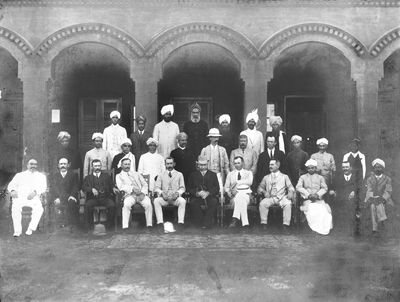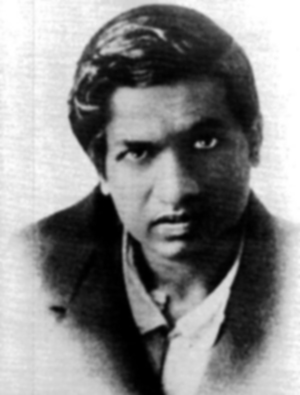
Sir Francis Spring (centre) and his team, with S. Narayana Iyer seated third from right. |
Bruce C. Berndt who, with Robert A. Rankin, wrote on Mathematics genius S. Ramanujan extensively, was quite put out when he saw a film in June 2009 in Bangalore titled God, Zero and Infinity on the life of Ramanujan, in which one of the narrators described S. Narayana Iyer, the then Chief Accountant of Madras Port Trust (who was not only Ramanujan’s superior officer but also a qualified mathematician himself and mentor of Ramanujan during his Port Trust days) as “an amateur mathematician” who never helped Ramanujan in his mathematical pursuits. To correct this “uncharitable remark and to defend Narayana Iyer in his absence,” as Berndt puts it, he wrote a monograph on Rao Bahadur S. Narayana Iyer.
Not much has been written about this simple, sincere but a very important individual in the life of Ramanujan. Thanks to his grandson, V. Viswanathan, now in the USA, who has been in touch with me, I have been able to get some details on Narayana Iyer, supplementing the details in Bruce Berndt’s monograph, The Chief Accountant and Mathematical Friend of Ramanujan – S. Narayana Iyer, released for publication in the American Mathematics Journal in September 2010.
Narayana Iyer was born in a family of Hindu priests on December 15, 1874 in Cumbam, near Madurai. A good student, he passed all his exams with distinction and earned the highest degree available at the time, an M.A. (in Mathematics), in the absence of PhD-s, while at St. Joseph’s College in Trichinopoly. He was offered a teaching position in the College which he accepted.
While he was with the College, he became acquainted with Francis Spring, then a senior railway officer based in Trichy. Spring was impressed with the mathematical knowledge Iyer possessed. When Spring was in 1900 appointed Chairman of the Madras Port Trust, he invited Narayana Iyer to join the Trust as his Office Manager. Over a period, in recognition of his skills, Narayana Iyer was promoted as Chief Accountant, the post he held at the time when Ramanujan was recruited by him as a clerk in the Accounts Department. Later, the Government of India took note of Iyer’s efficiency and loyalty and honoured him with the title Rao Bahadur.

S. Narayana Iyer |
A Hundred years ago this year the two met for the first time | 
S. Ramanujan. |
The Nellore Collector Ramachandra Rao, who was supporting Ramanujan in the early 1900s sent him to Narayana Iyer to seek his help in getting a job. Ramanujan carried his mathematical manuscripts also with him and showed them to Narayana Iyer just as he had showed them to others. But being a mathematician himself, Narayana Iyer was able to assess the depth of Ramanujan’s genius in Mathematics and offered to get him a permanent post with the Madras Port Trust where he could continue with his mathematical pursuits uninterrupted. He collected from Ramanujan a formal application for the post of a clerk in the Port Trust addressed to the Chief Accountant and appointed him immediately. Subsequently he became Ramanujan’s mentor, working with him after office hours and guided him in getting the recognition he deserved. He introduced Ramanujan to Francis Spring (who had by then been knighted and was Sir Francis Spring) and sought his support.
* * *
It was Narayana Iyer who drafted all the letters from Ramanujan to G.H. Hardy (only the mathematical calculations were Ramanujan’s), as admitted by Ramanujan himself in his final letter dated January 22, 1914 addressed to Hardy prior to his departure to England. It was also Narayana Iyer who accompanied Ramanujan to the University Senate to secure the Madras University scholarship.
Before deciding to undertake his journey to England, Ramanujan was undecided about the trip as he had reservations about (1) his poor educational qualifications, (2) his orthodox family background and strict vegetarianism, (3) his feeling that his English was not up to the mark, and (4) the fear that he might have to appear for some examinations to be allowed to go to England – and examinations were not his forté. He states all these reservations in his last letter to Hardy. But he states that he was assured by Hardy’s emissaries, who allayed his fears and assured him that he would face no problems in going to England.
Narayana Iyer accompanied Ramanujan to Ramanujan’s family deity Namagiri Amman in Namakkal and stayed with him in the temple precincts for three days. On the third night, Ramanujan suddenly woke from his sleep and told Narayana Iyer that the deity had appeared before him and wrote something on his tongue (this was told by Viswanathan’s mother Kamakshi to Viswanathan as was narrated by her father Narayana Iyer to her).
Avibakthanayaki, Narayana Iyer’s wife, bore him two daughters and a son. His second daughter Kamakshi married M.S. Venkataraman (1902- 1967), who joined the Madras Port Trust well after Ramanujan’s days. In 1947, M.S. Venkataraman, who was the first Indian to hold the post of Traffic Manger of the Port, was the first Indian to be asked to officiate as the Chairman of the Port (be it for a brief period). Later, he was appointed Administrator of the Port of Cochin.
While officiating as Chairman of the Madras Port Trust, Venkataraman got all the files relating to Ramanujan in the Port Trust Office collected and transferred them to the National Archives in Delhi to ensure they were preserved for posterity.
* * *
Bruce Berndt cites an incident he learnt from the descendants of Narayana Iyer. Narayana Iyer’s wife was considering a prospective alliance for her younger sister and requested Narayana Iyer to visit the young man and give his opinion. Narayana Iyer called on the prospective bridegroom and asked him just one question. Satisfied with the reply, he gave his approval for the marriage. The question he asked was, ‘What is the value of ‘phi’?’
This is one instance to show how mathematics was ingrained in Narayana Iyer.
Narayana Iyer was one of the founding members of the Indian Mathematical Club which was later re-named the Indian Mathematical Society. He was an office-bearer from the Club’s founding in 1907 till 1928, except for a period of four years from 1910 to 1914, when Ramanujan and he both worked on mathematical problems together. He probably wanted to devote more time for Mathematics in addition only to his office and family duties.
With the release in September 2010 of Bruce Berndt’s monograph titled The Chief Accountant and Mathematical Friend of Ramanujan – S. Narayana Iyer for publication in the American Mathematics Journal, there has come greater focus on the contributions of Narayana Iyer to Mathematics. But even greater is the way he helped Ramanujan become internationally known.
|